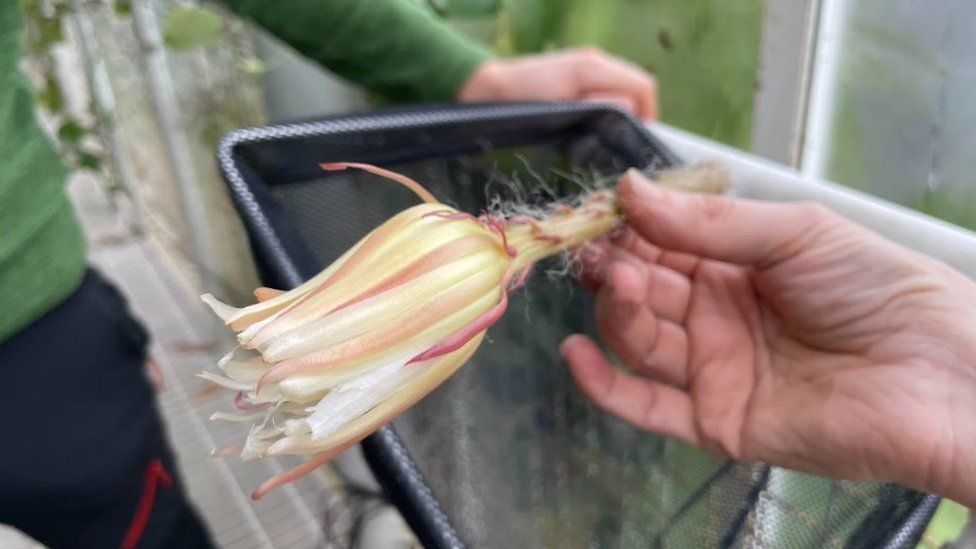Under the Cambridge microscope with the rare moonflower
- Published

A rare Amazonian cactus that blooms only once a year before its flower dies in just 12 hours has been put under the microscope for possibly the first time.
The moonflower, or Strophocactus wittii, is part of the collection at Cambridge University Botanic Garden.
It recently produced three flowers for the first time and as soon as the first faded, it was whisked off to the university's Sainsbury Laboratory.
Scientists hope to uncover its "secrets" and explain unusual cells.
It is relatively "rare" for the plants to bloom in captivity and when it happened in Cambridge in February 2021, it was believed to be the first time one had flowered in the UK.
A live webcam trained on the bud that year was watched by about 500,000 people around the world.
"The tropical cactus is... difficult to get hold of to study when its native habitat is in the Brazilian rainforest," a spokeswoman at the garden said.
However, with a microscope close at hand, scientists have taken advantage of this year's bloom.
"As far as they know, this is the first time the moonflower has been examined using an advanced low-temperature scanning electron microscope (cryo-SEM)," she added.
Dr Raymond Wightman, the lab's microscopy manager, said it was a "grab it and go moment - and within minutes it was under the microscope".
"It was a stroke of luck we had the microscope already set up for something that didn't happen - and we were able to take hundreds of photographs of this fresh specimen," he said.
"Hardly anything is known about this plant and we often can't be sure whether we're looking at petals, or sepals - the bud protectors - so in this case we call them 'tepals'. It means we're not sure what we're looking at, as everything is the same colour - a creamy-white."
He and his colleague, PhD student Kristina Buch, ran across the garden to get the flower once it had died off.
"Taking a closer look at the moonflower was a spontaneous wildcard," Ms Buch said.
"Over the past two years we have been using the cryo-SEM microscope to study petal surfaces across various plant species, but never those of a night-flowering plant, let alone of such a rare tropical specimen.
"This was an opportunity to take a closer look at the different petal-like structures layered into the flower, which we think are tepals - neither petals or sepals."
She said the images revealed "some surprises that deserve additional investigation".
Dr Wightman agreed, saying: "There were possibly some peculiar-shaped cells we've not seen before and some cells I didn't recognise - and it looks like it could be something non-typical.
"We'll go over the images, and then next year there might be more to look at, but it could take years before we have something to publish.
"However, we now have a permanent record of something so rare that we're not sure has ever been seen before under the microscope."
He added: "And it's always nice to see something different - it's a bit exciting and it wakes me up."
Follow East of England news on Facebook, Instagram and X. Got a story? Email [email protected] or WhatsApp 0800 169 1830
- Published17 February
- Published10 February
- Published1 February
- Published20 February 2021